The Common Crane (Grus grus), a majestic bird known for its elegance and haunting calls, is a species of immense ecological importance.
With its wide distribution across Europe, Asia, and parts of Africa, the Common Crane inhabits diverse wetland and grassland habitats, playing a vital role in these ecosystems.
Recognized for its striking appearance, characterized by long legs, a neck, and a distinctive red crown patch, the Common Crane has captivated human fascination for centuries.
Beyond its physical attributes, the Common Crane exhibits fascinating behavioral traits, including elaborate courtship displays, communal roosting, and long-distance migrations.
As a symbol of grace and resilience, the Common Crane serves as a flagship species for conservation efforts aimed at preserving wetland habitats and safeguarding biodiversity.
Understanding the biology and ecology of the Common Crane is essential for ensuring the continued survival and appreciation of this iconic bird species. Stay sharp.
How to Identify Common Crane?
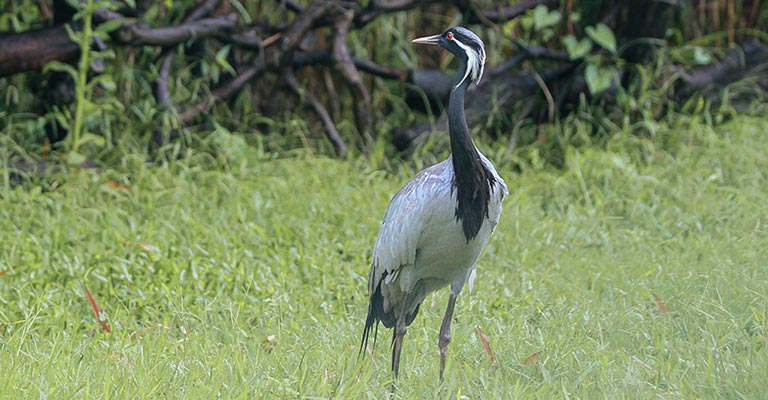
The Common Crane, also known as the Eurasian Crane or Grus grus, is a majestic bird known for its striking appearance and distinctive calls.
Identifying this species requires careful observation of various physical characteristics and behavioral traits. Here are some of the key points to help you identify the Common Crane:
Size and Shape
Common Cranes are large birds with long legs and necks, standing around 4 feet tall and possessing a wingspan of approximately 7 feet. They have a slender body, a long neck, and broad wings, giving them a graceful appearance in flight.
Plumage
The plumage of adult Common Cranes is predominantly gray, with a lighter gray on the head and neck and darker gray on the body and wings.
Their feathers are often mottled with shades of gray and brown, particularly on the wings and back. Juvenile birds may have slightly browner plumage than adults.
Head and Neck
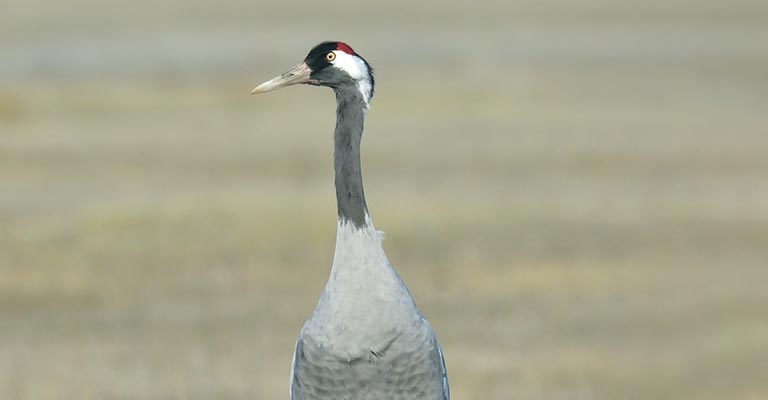
The head of the Common Crane is relatively small compared to its body, and it features a distinctive red crown patch on the forehead.
This patch is particularly prominent during the breeding season and serves as a key identifying feature. The neck is long and slender, often held in an S-shaped curve while in flight.
Flight Pattern
When in flight, Common Cranes exhibit a slow, steady wingbeat, with their necks extended and legs trailing behind.
They typically fly in V-shaped formations during migration, emitting a distinctive trumpeting call that is characteristic of the species.
Habitat
Common Cranes inhabit a variety of wetland and grassland habitats, including marshes, bogs, meadows, and agricultural fields.
During migration, they may also be found in coastal areas, estuaries, and open woodlands. Their preference for wetland habitats makes them particularly susceptible to habitat loss and degradation.
Behavior
Common Cranes are diurnal birds, meaning they are most active during the day. They are often seen foraging for food in fields and wetlands, using their long bills to probe for insects, seeds, roots, and small vertebrates.
They are also social birds, often congregating in large flocks, especially during migration and wintering periods.
Voice
The vocalizations of Common Cranes are distinctive and carry over long distances.
Their call is a loud, trumpeting, bugle-like sound, often described as “korr-ooo” or “trumpeting.” This call is used for communication within flocks and during courtship displays.
Distribution
Common Cranes have a wide distribution range across Europe, Asia, and parts of Africa.
They breed in northern Europe and Asia, with some populations migrating to wintering grounds in southern Europe, North Africa, and South Asia.
In recent years, efforts to reintroduce Common Cranes to areas where they were once extirpated have been successful, leading to expanding populations in certain regions.
By paying attention to these key characteristics, birdwatchers and enthusiasts can confidently identify the Common Crane in various habitats and geographical locations.
Taxonomy of Common Crane
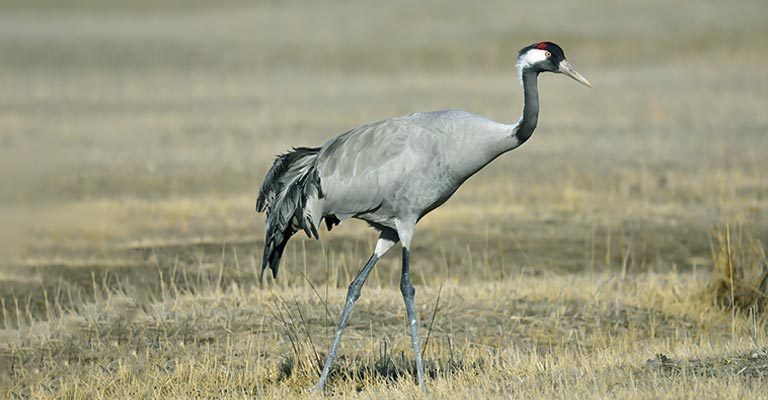
Here’s a table summarizing the taxonomy details of the Common Crane:
| Domain | Eukaryota |
| Kingdom | Animalia |
| Phylum | Chordata |
| Class | Aves |
| Order | Gruiformes |
| Superfamily | Gruoidea |
| Family | Gruidae |
| Genus | Grus |
| Species | G. americana |
The Common Crane belongs to the kingdom Animalia, phylum Chordata, class Aves (birds), order Gruiformes (cranes), and family Gruidae. Its scientific name is Grus Grus.
Within the genus Grus, it is classified alongside other crane species. The taxonomy reflects its evolutionary relationships, grouping it with other birds that share similar anatomical and genetic characteristics.
As a member of the family Gruidae, the Common Crane is closely related to other crane species, such as the Sandhill Crane and the Whooping Crane.
Understanding its taxonomy helps scientists study its biology, behavior, and ecological role within its ecosystem.
Reproduction of Common Crane
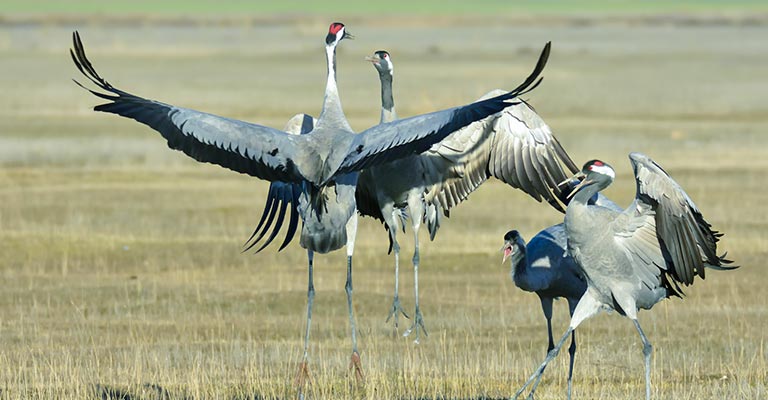
The Common Crane typically breeds in wetland areas and marshes, forming monogamous pairs during the breeding season.
Courtship displays involve elaborate dances, vocalizations, and aerial acrobatics, strengthening the bond between mates.
Nests are constructed on the ground in shallow depressions lined with grass and vegetation. The female usually lays two eggs, which both parents incubate for about a month.
Once hatched, the chicks are precocial, meaning they are born with their eyes open and covered in down feathers. Both parents take turns caring for the chicks, feeding them a diet of insects, small vertebrates, and plant matter.
The young cranes fledge in about two months but remain with their parents for some time, learning essential survival skills before becoming independent.
Common Crane Life History
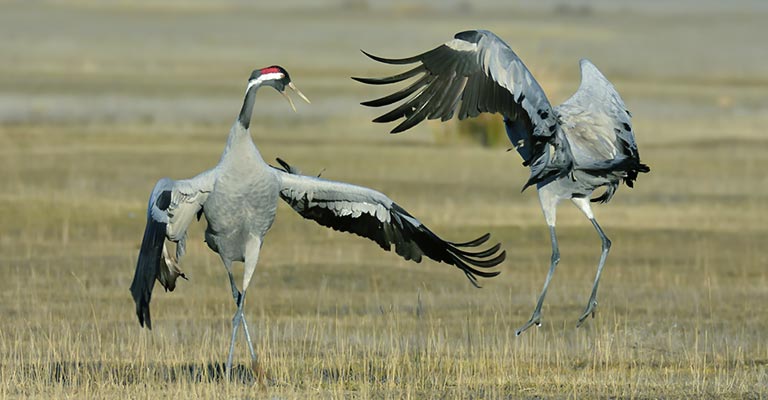
The Common Crane (Grus grus) is a magnificent bird known for its graceful appearance and haunting calls.
Found across Europe, Asia, and parts of Africa, this species inhabits a variety of wetland and grassland habitats, where it plays a crucial ecological role.
Understanding the life history of the Common Crane is essential for conservation efforts and ensuring the continued survival of this iconic species.
Food
Common Cranes are omnivorous birds with a diverse diet. They primarily feed on plant matter such as seeds, roots, and tubers but also consume insects, small vertebrates, and even small mammals.
Their foraging behavior involves probing the soil with their long bills in search of food, particularly in wetland habitats where they can find abundant prey.
Habitat
Common Cranes inhabit a range of wetland and grassland habitats, including marshes, bogs, meadows, and agricultural fields.
They are often associated with water bodies where they can forage for food and roost safely. During migration, they may also utilize coastal areas, estuaries, and open woodlands as stopover sites.
Range Map
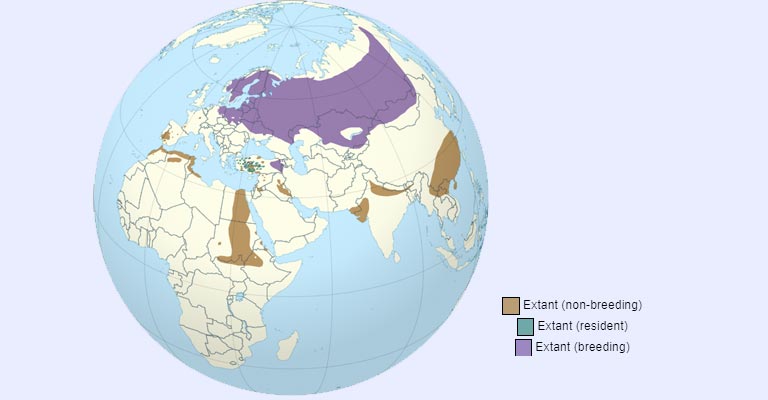
The range of the Common Crane extends across Europe, Asia, and parts of Africa.
Breeding populations are concentrated in northern Europe and Asia, while migratory populations can be found wintering in southern Europe, North Africa, and South Asia.
Conservation efforts aim to protect key habitats along their migration routes and breeding grounds.
Nesting
Common Cranes typically form monogamous pairs during the breeding season. Nests are constructed on the ground in shallow depressions lined with grass and vegetation.
The female lays two eggs, which are incubated by both parents for about a month. Once hatched, the chicks are precocial and rely on their parents for food and protection.
The below table detailing the nesting details of the Common Crane:
| Nesting Details | Common Crane |
| Clutch Size | Usually 2 eggs |
| Number of Broods | Typically 1 per breeding season |
| Egg Length | Approximately 10-12 cm |
| Egg Width | Approximately 6-8 cm |
| Incubation Period | Around 30 days |
| Nestling Period | About 60-70 days |
| Egg Description | Olive-brown to buff color, often with darker spots or markings |
| Nest Location | Constructed on the ground in shallow depressions |
| Incubation Duties | Both parents share incubation duties |
| Nest Material | Lined with grass and vegetation |
| Nest Protection | Chicks fledge at around 2 months of age but remain dependent on parents for some time |
| Fledging | Chicks fledge at around 2 months of age but remain dependent on parents for some time. |
This table provides a comprehensive overview of the nesting habits and characteristics of the Common Crane, including clutch size, egg dimensions, incubation period, nest location, and parental responsibilities.
Common Cranes typically construct their nests on the ground in shallow depressions lined with grass and vegetation. They usually lay a clutch of two eggs, which both parents incubate for about a month.
During this incubation period, the parents take turns sitting on the eggs to keep them warm and protected. Once hatched, the chicks are precocial and rely on their parents for food and protection.
Common Cranes are highly protective of their nesting sites and may display aggressive behavior towards intruders to ensure the safety of their offspring.
Diseases and Treatment
Common Cranes are susceptible to various diseases, including avian influenza and West Nile virus.
Conservation efforts often involve monitoring for disease outbreaks and implementing measures to prevent transmission, such as habitat management and vaccination programs.
Conservation
The Common Crane faces threats from habitat loss, degradation, and hunting.
Conservation initiatives focus on protecting key breeding and wintering habitats, implementing sustainable land management practices, and raising awareness about the importance of crane conservation.
Collaborative efforts involving governments, conservation organizations, and local communities are essential for ensuring the long-term survival of this iconic species.
10 Behavioral Habits of Common Crane
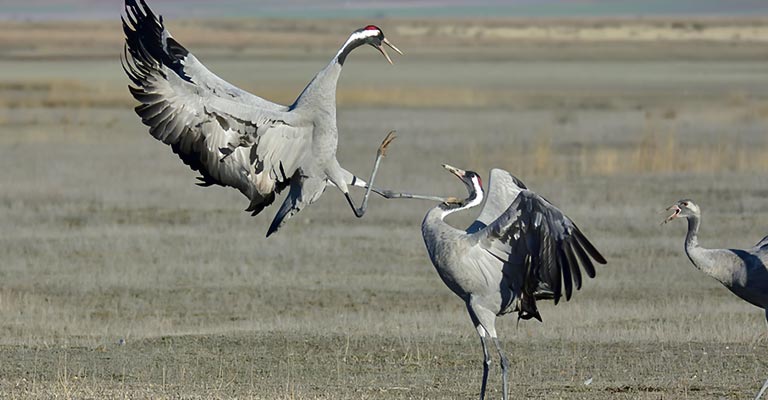
The Common Crane (Grus grus) exhibits a range of fascinating behavioral habits that contribute to its survival and success in various habitats across its range.
Understanding these behaviors provides insight into the lifestyle and ecology of this iconic bird species.
- Sociality: Common Cranes are highly social birds, often congregating in large flocks, particularly during migration and wintering periods. They exhibit complex social interactions within these flocks, communicating through vocalizations and body language.
- Courtship Displays: During the breeding season, Common Cranes engage in elaborate courtship displays, which involve dancing, vocalizations, and aerial acrobatics. These displays strengthen pair bonds and play a crucial role in mate selection.
- Parental Care: Both parents participate in caring for their young, sharing responsibilities such as incubating the eggs, feeding the chicks, and protecting the nest from potential threats.
- Foraging Behavior: Common Cranes are omnivorous birds with a diverse diet. They forage for food in wetland and grassland habitats, using their long bills to probe the soil for insects, seeds, roots, and small vertebrates.
- Vocalizations: Common Cranes are known for their loud and distinctive trumpeting calls, which carry over long distances. These vocalizations serve various purposes, including communication within flocks, maintaining social cohesion, and defending territory.
- Migration: Common Cranes undertake long-distance migrations between breeding and wintering grounds, often traveling thousands of kilometers. They follow traditional migration routes, relying on environmental cues and landmarks for navigation.
- Aggression: Common Cranes can display aggressive behavior, particularly when defending their nesting territory or protecting their young from predators. They may engage in threat displays, vocalizations, or physical confrontations to deter intruders.
- Roosting Behavior: At night, Common Cranes gather in communal roosting sites, where they rest and socialize before resuming their activities at dawn. These roosts provide safety in numbers and facilitate social interactions among flock members.
- Territoriality: During the breeding season, Common Cranes establish territories, which they defend against intruders through vocalizations and displays of aggression. Territories are typically centered around nesting sites and foraging areas.
- Learning and Adaptation: Common Cranes exhibit learning and adaptive behaviors, such as adjusting their foraging strategies in response to changes in habitat availability or environmental conditions. They also learn from parental care and social interactions within their flocks, contributing to their overall survival and reproductive success.
By exhibiting these behavioral habits, the Common Crane demonstrates its remarkable adaptability and resilience in diverse ecosystems, ensuring its continued presence and significance in the natural world.
Wrapping Up
The common Crane (Grus grus) exemplifies the beauty and complexity of avian life. Its striking appearance, intricate behaviors, and vital ecological role make it a captivating species deserving of admiration and conservation efforts.
From its majestic courtship displays to its diligent parental care and impressive migratory journeys, the Common Crane’s existence enriches our understanding of the natural world and highlights the interconnectedness of ecosystems.
However, the species faces threats such as habitat loss, pollution, and climate change, underscoring the urgency of conservation measures to safeguard its future.
Through collaborative efforts, including habitat protection, sustainable land management, and public awareness campaigns, we can ensure that the Common Crane continues to grace our skies and wetlands for generations to come.
By valuing and protecting this iconic bird, we not only preserve a symbol of wildness and freedom but also uphold the integrity and diversity of our planet’s rich biodiversity. Thank you very much.
